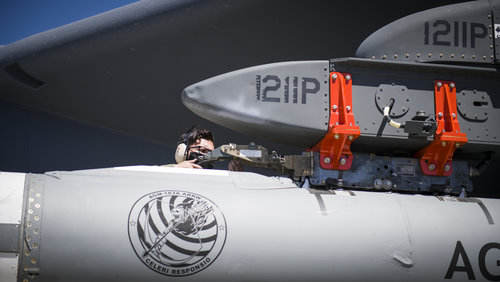I thought ARRW was a reworked HTV-2. That was flown twice. It terminated early in both but had enough data to confirm the aerodynamics/flight control seemed to work. I believe it was the thermal protection on the 2nd flight that caused problems.
You are using an out of date browser. It may not display this or other websites correctly.
You should upgrade or use an alternative browser.
You should upgrade or use an alternative browser.
Lockheed Martin AGM-183 Air-Launched Rapid Response Weapon (ARRW)
- Thread starter Moose
- Start date
- Joined
- 3 June 2011
- Messages
- 18,305
- Reaction score
- 12,130
I thought ARRW was a reworked HTV-2. That was flown twice. It terminated early in both but had enough data to confirm the aerodynamics/flight control seemed to work. I believe it was the thermal protection on the 2nd flight that caused problems.
No way. That thing was launched with a Peacekeeper ICBM (essentially).
No way. That thing was launched with a Peacekeeper ICBM (essentially).
If you read the April 2020 issue of Air Force magazine, there is an article starting on page 28 covering the various hypersonic projects. At the bottom of page 29 it says (paraphrasing):
The DARPA program, called Tactical Boost Glide was to serve as the basis for ARRW
The appearance of the ARRW and HTV-2 are pretty similar. I can believe the HTV-2 was bigger and needed a large booster but a scaled down version might still be the design base for ARRW.
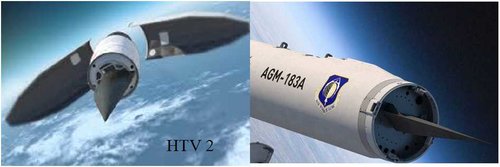
bring_it_on
I really should change my personal text
- Joined
- 4 July 2013
- Messages
- 3,638
- Reaction score
- 3,753
It is undoubtedly the more advanced design with greater capability. Just hoping the flight testing goes well. Worst case, presumably HCSW could be dusted off next year if major problems arise. The glider is supposed to be from DARPA TBG - has that ever been flight tested?
No it hasn't been flight tested, but the ARRW program will follow after TBG has been flight tested which should happen sometime in the short term. TBG also has a second vendor allowing the USAF to re-evaluate at a later date in terms of which BGV the prefer for the long term. So basically by keeping TBG and ARRW alive (USAF has funding for TBG as well as it was a joint USAF-DARPA effort) they are bringing three BGV's through flight demonstrations (C-HGV, TBG-LM, TBG-RTX). That is a better ROI for USAF and broader DOD R&D dollars than going all in on just one. At the end of the day they have to establish an acquisition program for the ARRW and then build some sort of acquisition program that right sizes the buy to make all this affordable.
Last edited:
- Joined
- 3 June 2011
- Messages
- 18,305
- Reaction score
- 12,130
Is there a warhead on this or is it pure kinematics to destroy the target?
Wouldn't matter. The booster is only 30" dia. Makes the glider what. . .5" thick, maybe?
If there is a warhead, I think it would only be a bursting charge to fragment the glider for soft targets. The diameter as noted above is ~31 inches/80cm; there couldn't be room for much more than a guidance, power source, and control surfaces.
Dilandu
I'm dissatisfied, which means, I exist.
If there is a warhead, I think it would only be a bursting charge to fragment the glider for soft targets. The diameter as noted above is ~31 inches/80cm; there couldn't be room for much more than a guidance, power source, and control surfaces.
Er, Tomahawk is 52 cm in diameter and carry 450-kg wahread.
Firefinder
ACCESS: Top Secret
- Joined
- 5 October 2019
- Messages
- 1,041
- Reaction score
- 1,889
The Tomahawk is also a one piece weapon basically with a small booster.If there is a warhead, I think it would only be a bursting charge to fragment the glider for soft targets. The diameter as noted above is ~31 inches/80cm; there couldn't be room for much more than a guidance, power source, and control surfaces.
Er, Tomahawk is 52 cm in diameter and carry 450-kg wahread.
The AGM183 is mostly booster with a small missile part. That black arrow head on the end of the weapon.
That is the AGM183 kill vehicle, that is the part that flys off to do the work and ONLY THAT. The rest of it is basically a booster to get up to speed and attitude. Think more Saturn 5 set up, BIG OLD ROCKET, with an itty bitty tiny command and life support module. That little arrow head has all the eletrics, batteries, fuel, and the warhead to hit the target with.
More over, not only is the terminal glider not very wide, the shaping of the projectile means it will be waffer thin. The conical glider the USN is developing will have much more room, but will be less aerodynamically efficient.
bring_it_on
I really should change my personal text
- Joined
- 4 July 2013
- Messages
- 3,638
- Reaction score
- 3,753
Any warhead or kill capability will be based on the ARRWs target set which would have been defined by the USAF quite early on (when they put the T in TBG). That would also impact guidance and other trades.
Firefinder
ACCESS: Top Secret
- Joined
- 5 October 2019
- Messages
- 1,041
- Reaction score
- 1,889
Then again the size of guidance systems have shunk a lot in the last ten hears.Any warhead or kill capability will be based on the ARRWs target set which would have been defined by the USAF quite early on (when they put the T in TBG). That would also impact guidance and other trades.
It is now possible to make a quad mode seeker the size of a cellphone these days, looking at the GDU53s. Hell the Army has a tiny GPS guidance kit in the PGK. And batteries have come an extremely long way too.
Either way, it will not surprise me if the Arrw has a sizeable warhead thanks to the guidance being tiny.
BDF
ACCESS: Secret
- Joined
- 14 March 2009
- Messages
- 284
- Reaction score
- 423
Is there a speculated range and impact velocity for the warhead? My google-fu hasn't really found much. Did see one article speculating on 2,000km range but that seems high to me. I've read Mach 20 as well but I'm not convinced that's it impact velocity.
- Joined
- 3 June 2011
- Messages
- 18,305
- Reaction score
- 12,130
Is there a speculated range and impact velocity for the warhead? My google-fu hasn't really found much. Did see one article speculating on 2,000km range but that seems high to me. I've read Mach 20 as well but I'm not convinced that's it impact velocity.
Mach 20 has nothing to do with this vehicle, anywhere in it's flight profile, at impact or no.
bring_it_on
I really should change my personal text
- Joined
- 4 July 2013
- Messages
- 3,638
- Reaction score
- 3,753
Is there a speculated range and impact velocity for the warhead? My google-fu hasn't really found much. Did see one article speculating on 2,000km range but that seems high to me. I've read Mach 20 as well but I'm not convinced that's it impact velocity.
Is there a speculated range and impact velocity for the warhead? My google-fu hasn't really found much. Did see one article speculating on 2,000km range but that seems high to me. I've read Mach 20 as well but I'm not convinced that's it impact velocity.
Mach 20 has nothing to do with this vehicle, anywhere in it's flight profile, at impact or no.
A 1,000 km range has been attributed to the ARRW by the defense media and later used in a bunch of CRS reports. Not sure whether any official USAF publication has cited it but that is what we have to go by for now.
bring_it_on
I really should change my personal text
- Joined
- 4 July 2013
- Messages
- 3,638
- Reaction score
- 3,753
One would think that the 1,000 km number came to the media via the AF or Lockheed and if so would likely represent some sort of realistic range of the weapon given its intended use case. I think it was first reported by Steve Trimble. Even then, I don't think you'd want to spend a Billion dollars developing the weapon, and then a considerable amount trying to create an industrial base to produce them, just to launch them as if you were launching a ballistic missile. These would be reserved for, at least initially, the harder to reach targets, or those that are extremely time-critical.
aonestudio
I really should change my personal text
- Joined
- 11 March 2018
- Messages
- 2,962
- Reaction score
- 7,475
A B-52H Stratofortress assigned to the 419th Flight Test Squadron takes off from Edwards Air Force Base, California, Aug. 8. The aircraft conducted a captive-carry flight test of the AGM-183A Air-launched Rapid Response Weapon Instrumented Measurement Vehicle 2 hypersonic prototype at the Point Mugu Sea Range off the Southern California coast.







Air Force conducts latest hypersonic weapon flight test
The Air Force took another step towards fielding a hypersonic weapon following its final captive-carry test of the AGM-183A Air-launched Rapid Response Weapon under a wing of a B-52 Stratofortress off
www.edwards.af.mil
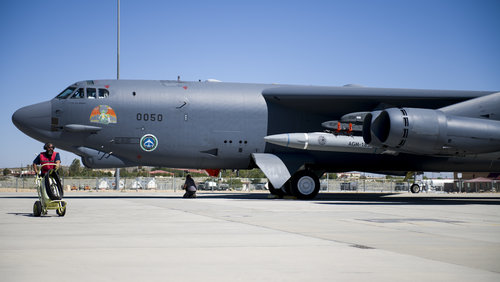
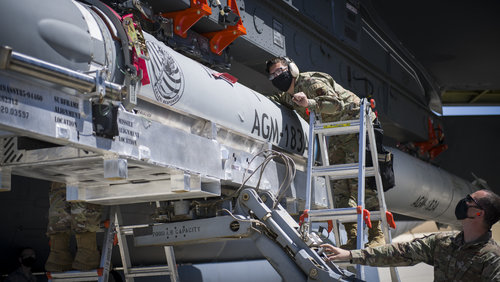
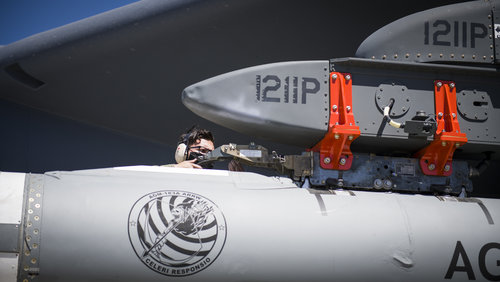
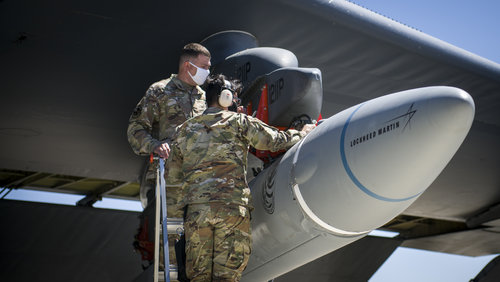
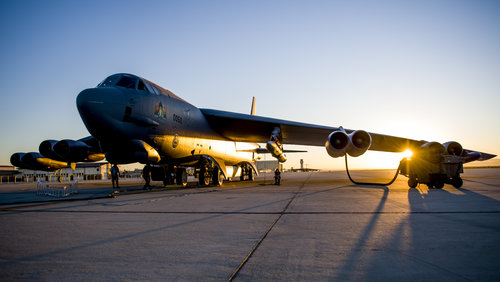
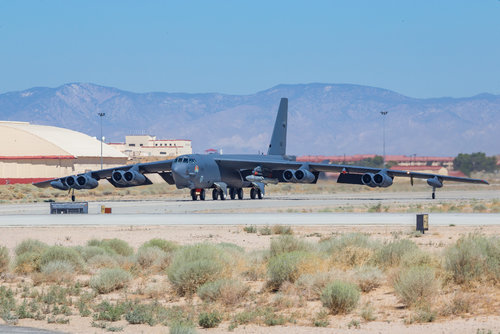
dark sidius
ACCESS: Top Secret
- Joined
- 1 August 2008
- Messages
- 1,193
- Reaction score
- 1,066
Thank you I just say WOAW !! Do you think it will fit inside the B-21 bay ?
Last edited:
TAOG
I really should change my personal text
- Joined
- 7 October 2018
- Messages
- 108
- Reaction score
- 237
ARRW's range: "handfuls of hundreds of miles"?
"...DOD describes its hypersonics programs with terms like “medium” or “long” range. What does that mean?
“We’re very cautious about attaching numbers to exactly what we mean,” Lewis said in an interview. “All these systems wind up flying really long distances.”
For medium range, though, he said, “we’re talking about handfuls of hundreds of miles. Long range, we’re talking … a couple thousand nautical miles. It’s intentionally fuzzy.” The Pentagon, he said, is “still figuring out the concepts. That’s part of what we’re going to be exploring with our upcoming flight tests.”..."

 www.airforcemag.com
www.airforcemag.com

"...DOD describes its hypersonics programs with terms like “medium” or “long” range. What does that mean?
“We’re very cautious about attaching numbers to exactly what we mean,” Lewis said in an interview. “All these systems wind up flying really long distances.”
For medium range, though, he said, “we’re talking about handfuls of hundreds of miles. Long range, we’re talking … a couple thousand nautical miles. It’s intentionally fuzzy.” The Pentagon, he said, is “still figuring out the concepts. That’s part of what we’re going to be exploring with our upcoming flight tests.”..."

The Hypersonics Push | Air & Space Forces Magazine
Pentagon leaders provide a first look at plans for testing and producing future hypersonic weapons.

Last edited:
Is it just me or ARRW diameter look very small? barely thicker than JASSMA B-52H Stratofortress assigned to the 419th Flight Test Squadron takes off from Edwards Air Force Base, California, Aug. 8. The aircraft conducted a captive-carry flight test of the AGM-183A Air-launched Rapid Response Weapon Instrumented Measurement Vehicle 2 hypersonic prototype at the Point Mugu Sea Range off the Southern California coast.

Air Force conducts latest hypersonic weapon flight test
The Air Force took another step towards fielding a hypersonic weapon following its final captive-carry test of the AGM-183A Air-launched Rapid Response Weapon under a wing of a B-52 Stratofortress offwww.edwards.af.mil
View attachment 638973View attachment 638969View attachment 638970View attachment 638971View attachment 638972View attachment 638974
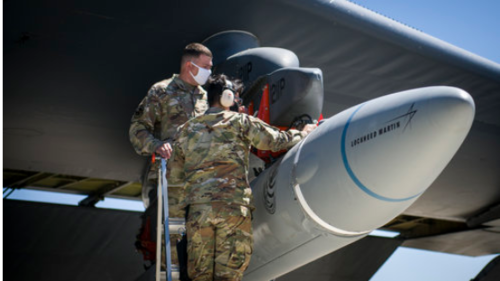
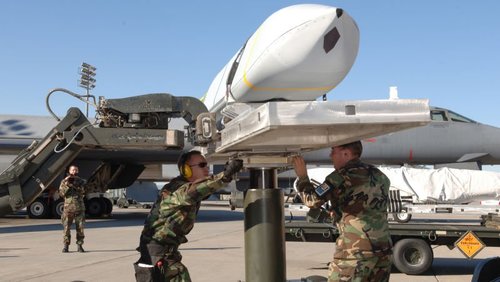
Bhurki
ACCESS: Secret
- Joined
- 16 July 2020
- Messages
- 345
- Reaction score
- 382
Jassm is 550mm wide, Arrw is 750mm.Is it just me or ARRW diameter look very small? barely thicker than JASSMA B-52H Stratofortress assigned to the 419th Flight Test Squadron takes off from Edwards Air Force Base, California, Aug. 8. The aircraft conducted a captive-carry flight test of the AGM-183A Air-launched Rapid Response Weapon Instrumented Measurement Vehicle 2 hypersonic prototype at the Point Mugu Sea Range off the Southern California coast.

Air Force conducts latest hypersonic weapon flight test
The Air Force took another step towards fielding a hypersonic weapon following its final captive-carry test of the AGM-183A Air-launched Rapid Response Weapon under a wing of a B-52 Stratofortress offwww.edwards.af.mil
View attachment 638973View attachment 638969View attachment 638970View attachment 638971View attachment 638972View attachment 638974
View attachment 639064
View attachment 639063
The shot makes you see the entire breadth of jassm while arrw full aspect diameter is not visible.
where did you get the ARRW diameter from?Jassm is 550mm wide, Arrw is 750mm.
The shot makes you see the entire breadth of jassm while arrw full aspect diameter is not visible.
Bhurki
ACCESS: Secret
- Joined
- 16 July 2020
- Messages
- 345
- Reaction score
- 382
30' x 270', 7300 lbs was mentioned for F-15ex centreline hardpoint carry.where did you get the ARRW diameter from?Jassm is 550mm wide, Arrw is 750mm.
The shot makes you see the entire breadth of jassm while arrw full aspect diameter is not visible.
Edit: 30' is 762mm
Bhurki
ACCESS: Secret
- Joined
- 16 July 2020
- Messages
- 345
- Reaction score
- 382
"For the test, the B-52 was loaded with two representative ARRW Instrumented Measurement Vehicles (IMVs) carried in tandem under the port wing pylon. The forward missile of the pair was the principal trials subject, known as IMV-2. After flying a series of orbits to the north of Edwards, the B-52 transited to the Point Mugu Sea Range, south of the Channel Islands off the coast of southern California. From there IMV-2 transmitted positional and telemetry data to the range’s ground stations."The missiles have different paint schemes. Is one instrumented and one just a dummy round?
Yes, IMV-1 was the aft store and was unpowered."For the test, the B-52 was loaded with two representative ARRW Instrumented Measurement Vehicles (IMVs) carried in tandem under the port wing pylon. The forward missile of the pair was the principal trials subject, known as IMV-2. After flying a series of orbits to the north of Edwards, the B-52 transited to the Point Mugu Sea Range, south of the Channel Islands off the coast of southern California. From there IMV-2 transmitted positional and telemetry data to the range’s ground stations."The missiles have different paint schemes. Is one instrumented and one just a dummy round?
Bhurki
ACCESS: Secret
- Joined
- 16 July 2020
- Messages
- 345
- Reaction score
- 382
“This thing is going to be able to go, in 10-12 minutes, almost 1,000 miles,” Gebara said. “It’s amazing.”

 www.airforcemag.com
www.airforcemag.com

BUFF Up | Air & Space Forces Magazine
Another decade of enhancements will give the B-52 three more decades of power.
Last edited:
bring_it_on
I really should change my personal text
- Joined
- 4 July 2013
- Messages
- 3,638
- Reaction score
- 3,753
- Joined
- 21 April 2009
- Messages
- 13,732
- Reaction score
- 7,617

Roper: ARRW Hypersonic Missile Will Fly This Month | Air & Space Forces Magazine
USAF will flight test the U.S. military’s first hypersonic missile this month, Air Force Acquisition boss Will Roper said Dec. 14.
- Joined
- 18 May 2019
- Messages
- 640
- Reaction score
- 1,672
bring_it_on
I really should change my personal text
- Joined
- 4 July 2013
- Messages
- 3,638
- Reaction score
- 3,753

AGM-183 Hypersonic Weapon Still Awaiting First Flight | Air & Space Forces Magazine
The Air Force’s AGM-183 hypersonic missile didn’t fly by the end of December, as predicted by service acquisition executive Will Roper last month.
- Joined
- 21 April 2009
- Messages
- 13,732
- Reaction score
- 7,617

Air Force About to Make First Hypersonic Missile Flight, After Recent Failure | Air & Space Forces Magazine
The AGM-183A Air-launched Rapid Response Weapon will make its first all-up flight within the next seven days, hypersonics experts revealed at vAWS.
- Joined
- 21 April 2009
- Messages
- 13,732
- Reaction score
- 7,617

Hypersonics: ARRW's Booster Tests This Week - Carefully - Breaking Defense
As the services rush to field hypersonics, OSD’s top expert warns, they must not repeat sloppy mistakes that have marred past tests – and hypersonic cruise missiles may have more tactical value than easier-to-build boost-glide weapons.
seruriermarshal
ACCESS: Top Secret
- Joined
- 4 May 2008
- Messages
- 1,180
- Reaction score
- 573
ARRW = AGM-183A ?
ARRW = AGM-183A ?
Yes.
- Joined
- 3 June 2011
- Messages
- 18,305
- Reaction score
- 12,130
yesARRW = AGM-183A ?
Similar threads
-
-
Hypersonic Conventional Strike Weapon (HCSW)
- Started by bring_it_on
- Replies: 30
-
-
-

